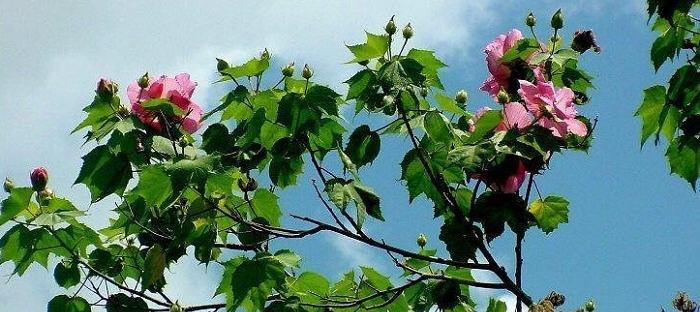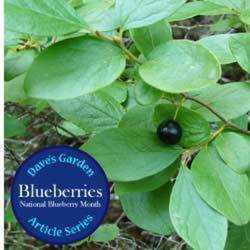With fall comes remarkable flowers that change color almost by the hour. We gardeners of the South are proud to adopt the Confederate rose as one of our own.
One story relates that the Confederate rose was in bloom during a particularly bloody battle of the Civil War. A slain soldier fell beside a Confederate rose, and his blood spilled into the ground at the base of shrub. The flowers, which had started out white in the morning, absorbed the slain soldier's blood throughout the day, so that by evening they had turned a deep, rosy red.
That sort of story makes for interesting reading, but the flowers do, indeed, live up the specific epithet, "mutabilis," which means "variable or changeable." All are large and showy and look somewhat like a large, delicate rose. Some are single, and many are double. On some specimens, the flowers that open early in the morning are snowy white, but by evening they have turned to deep rose. On the second day, they wither and fall from the shrub. On other shrubs, the opening blossom may be pink, turning to white or even a darker pink as it ages. Either way, many buds are waiting for their day in the sun. At any time, as many as three different colors may show at one time as the flowers fade or darken to their various hues. On some single-flowered specimens, flowers are red and remain so for the duration of their bloom. Some are pink and gradually turn a darker shade of pink as they age.
The Confederate rose is a large shrub or small multi-stemmed tree capable of growing up to 15 feet tall and about 10 feet wide. Large, deeply lobed 5- to 7-inch leaves are attractive throughout the summer, during which time they add a distinctive, coarse texture that contrasts well with other, more finely textured compatriots. Following the bloom, a seed capsule reminiscent of a cotton boll, dries and yields its fuzzy seeds. This trait calls to mind why another of its common names is cotton rose. Like many other plants with seasonal bloom, hardly anybody notices the Confederate rose in spring and summer. When fall rolls around and the shrubs begin flowering, nobody can miss their striking beauty.

Hardiness
Confederate rose exhibits some degree of hardiness in USDA Zones 7-9. In my Zone 8B garden it gets killed to the ground most winters, but it comes back from the roots every spring. All summer it spends growing and producing strong woody stems and big, tropical-looking leaves. Rounded buds begin appearing about August, and in September or October and until frost, the Confederate rose struts its stuff.
In frost-free areas, Confederate rose blooms throughout the winter. In places that have light frosts, the leaves are shed, but they sprout again from sturdy, undamaged stems in spring. In areas with prolonged cold periods and frequent heavy frosts, the stems are killed to the ground, but the plant re-grows from hardy roots the following spring. Our poor cousins to the north where the ground freezes must grow their confederate roses in containers and move them to protected places in winter or simply treat them as annuals.
Culture
Like many other plants, Confederate rose does best in rich, well-drained but moist soil and full sun. However, it is highly adaptable and will perform reasonably well in almost any soil as long as it drains well. It is well worth growing even if you cannot provide the conditions for maximum performance. Some blooms will be produced in partial shade, and the plant is tolerant of a wide range of soils. Even though it appreciates regular watering, it can get by with much less and is even drought tolerant in good soil.
Confederate rose can be plagued by insect pests such as white flies, scale insects, weevils, and caterpillars. If the infestation is severe, spraying with an insecticide approved for hibiscus and recommended for the particular pest may be necessary. Systemic insecticide drenches or granules that are applied to the ground and absorbed by the plant's roots are sometimes useful in the battle against persistent pests.
Propagation
Before the first frost, folks in my neck of the woods take cuttings. They know that the stems will die after a hard frost or freeze. If the stems are cut before they are damaged by the cold, however, they will make hundreds of cuttings. Even the hard, woody stems root easily in water or in damp soil. If kept from freezing, the cut ends will callus over, roots will form, and the cuttings will be ready to plant in the landscape or share with friends the following spring.
In the Landscape
Most country folks and others who have space to do so, grow the Confederate rose as a free-standing specimen. In such a place, it grows to its maximum potential into a natural, oval shape, and its beautiful, various-hued flowers are shown to their best advantage. If space allows, plant Confederate rose in the front yard so that it can be seen by all passersby. If space is simply not available, the Confederate rose is good addition to a mixed shrub border.
At any rate, the Confederate rose will be the talk of the neighborhood when it is in full bloom. It is particularly welcome in the fall when many of the summer-flowering plants have bloomed out and the garden needs an extra boost.
Images courtesy of PlantFiles


















